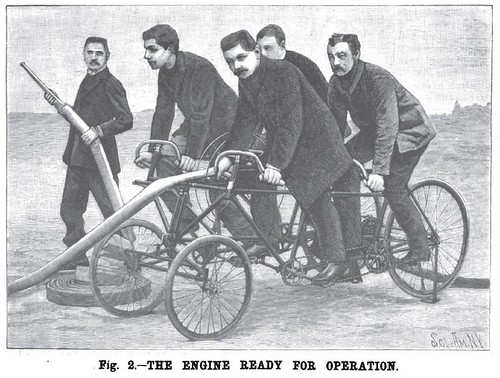
Figure 1 - Quadricycle Fire Engine
A QUADRICYCLE FIRE ENGINEAn interesting notion - I don't believe this caught on in the U.S. In a radius of travel less than a couple of miles and with relatively flat terrain, this could make sense, but notwithstanding the advantages of quick response cited, one can imagine fire fighting personnel would prefer not to pedal to fires.
We illustrate herewith a quadricycle fire engine that attracted considerable attention at the recent bicycle exhibition at Paris, and which presents unquestionable advantages over the hand engines in use in all places that are too small to afford the luxury of steam fire apparatus.
As shown by our engravings (Figs. 1 and 2), the engine consists of two tandem bicycles coupled by crosspieces in front and behind and having but a single steering post in front. The free space between the two frames is occupied at the front by a hose reel, in the center by a rotary pump, and at the back by a coupling that allows the pump to be put in communication with a water tap.
This entire affair weighs scarcely more than 180 or 188 pounds, which represents about 88 pounds per man. [This per man figure does not seem right, whether the riders' weight is factored in or not, but is what is stated in the original.] It will be seen that upon such a machine four trained cyclists can reach a fire at a speed that could never be attained by fire engines drawn by horses.
Figure 2 - Ready for Operations
As soon as the engine has reached a favorable position, the four men jump from their seats, and, while two of them adjust the couplings, a third unreels the hose, and the fourth, turning down the jointed support, raises the back of the machine and throws the pump into gear.
The four men afterward get into their saddles and pedal in situ with a mean velocity that causes the pump to discharge about 4,500 gallons an hour in the form of a stream 100 feet in length in a horizontal direction and about 75 feet upwardly. These figures are those obtained at the trials made at the Palace of Industry on the 23d of last December.
All the preparatory maneuvers require scarcely more than two or three minutes. If, on another hand, we take into consideration the fact that such machines, propelled by men with some little training, can reach a fire in a quarter or a third of the time made by ordinary hand engines, we shall realize how great an interest attaches to the use of them in country places where a fire so easily assumes the importance of a disaster by reason of the tardiness with which the first help comes. Everything, therefore, leads to the belief that this invention is destined to completely revolutionize the fire apparatus of small towns and villages.
Video from Library of Congress showing the competing horse-centric approach

No comments:
Post a Comment